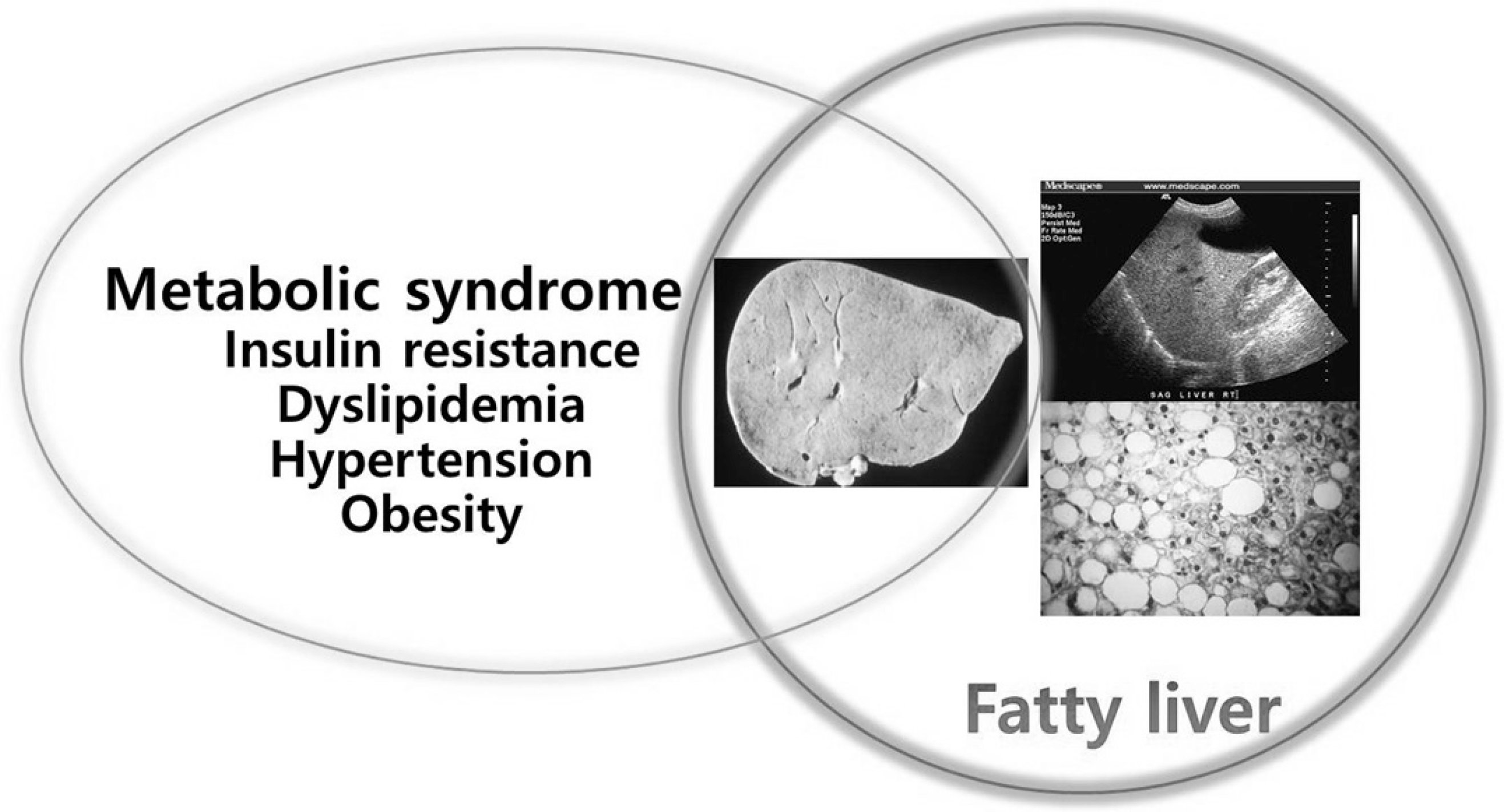Abstract
Non-alcoholic fatty liver disease (NAFLD) is a chronic condition characterized by fat accumulation combined with low-grade inflammation in the liver. A large body of clinical and experimental data shows that an increased flux of free fatty acids from increased visceral adipose tissue can lead to NAFLD and insulin resistance. Thus, patients with obesity, insulin resistance, and dyslipidemia are at the greatest risk for NAFLD. Many people believe NAFLD is one of the phenotypes of metabolic syndrome or insulin resistance.
In the United States, NAFLD prevalence was reported to be approximately 34% in the adult population. In previous studies performed in Korea, NAFLD prevalence varied from 17.9% to 27.4%, depending on the study populations and diagnostic methods. Prevalence of NAFLD confirmed by liver biopsy was 51.4% in living liver donors in Korea. Recent data showed that NAFLD prevalence was 27.3% (38.3% in men and 12.6% in women) among 161,891 Seoul and Gyeonggi-province residents receiving a health examination from January 2009 to December 2010.
Insulin resistance is a major feature and pathogenic factor of NAFLD. Theoretically, genetic variation in candidate genes related to insulin resistance may contribute to the pathogenesis of NAFLD. A recent genetic study using the significance analysis of microarrays method reported that 21 candidate genes, from a pool containing thousands of genes, were involved in NAFLD and insulin resistance. Comprehensive investigation of common genes that are potentially pathogenic in the development of NAFLD is warranted.
References
1. Clark JM, Brancati FL, Diehl AM. Nonalcoholic fatty liver disease. Gastroenterology. 2002; 122:1649–57.

2. Matteoni CA, Younossi ZM, Gramlich T, Boparai N, Liu YC, McCullough AJ. Nonalcoholic fatty liver disease: a spectrum of clinical and pathological severity. Gastroenterology. 1999; 116:1413–9.
3. Bookman ID, Pham J, Guindi M, Heathcote EJ. Distinguishing nonalcoholic steatohepatitis from fatty liver: serum-free fatty acids, insulin resistance, and serum lipoproteins. Liver Int. 2006; 26:566–71.

4. Sinn DH, Gwak GY, Park HN, Kim JE, Min YW, Kim KM, Kim YJ, Choi MS, Lee JH, Koh KC, Paik SW, Yoo BC. Ultrasonographically detected non-alcoholic fatty liver disease is an independent predictor for identifying patients with insulin resistance in nonobese, nondiabetic middle-aged Asian adults. Am J Gastroenterol. 2012; 107:561–7.

5. Lee JY, Kim KM, Lee SG, Yu E, Lim YS, Lee HC, Chung YH, Lee YS, Suh DJ. Prevalence and risk factors of non-alcoholic fatty liver disease in potential living liver donors in Korea: a review of 589 consecutive liver biopsies in a single center. J Hepatol. 2007; 47:239–44.

6. Kim HJ, Kim HJ, Lee KE, Kim DJ, Kim SK, Ahn CW, et al. Metabolic significance of nonalcoholic fatty liver disease in nonobese, nondiabetic adults. Arch Intern Med. 2004; 164:2169–2175.

7. Seo SH, Lee HW, Park HW, Jang BG, Chung WJ, Park KS, et al. Prevalence and associated factors of nonalcoholic fatty liver disease in the health screen examinees. Korean J Med. 2006; 70:26–32.
8. Bae JC, Cho YK, Lee WY, Seo HI, Rhee EJ, Park SE, et al. Impact of nonalcoholic fatty liver disease on insulin resistance in relation to HbA1c levels in nondiabetic subjects. Am J Gastroenterol. 2010; 105:2389–2395.

9. Sinn DH, Gwak GY, Park HN, Kim JE, Min YW, Kim KM, et al. Ultrasonographically detected non-alcoholic fatty liver disease is an independent predictor for identifying patients with insulin resistance in nonobese, nondiabetic middle-aged Asian adults. Am J Gastroenterol. 2012; 107:561–567.

10. Jeong EH, Jun DW, Cho YK, Choe YG, Ryu S, Lee SM, Jang EC. Regional prevalence of non-alcoholic fatty liver disease in Seoul and Gyeonggi-do, Korea. Clin Mol Hepatol. 2013; 19:266–72.

11. Nakamuta M, Kohjima M, Higuchi N, Kato M, Kotoh K, Yoshimoto T, Yada M, Yada R, Takemoto R, Fukuizumi K, Harada N, Taketomi A, Maehara Y, Nakashima M, Enjoji M. The significance of differences in fatty acid metabolism between obese and nonobese patients with non-alcoholic fatty liver disease. Int J Mol Med. 2008; 22:663–7.
12. Towle HC. Glucose as a regulator of eukaryotic gene transcription. Trends Endocrinol Metab. 2005; 16:489–94.

13. Postic C, Girard J. Contribution of de novo fatty acid synthesis to hepatic steatosis and insulin resistance: lessons from genetically engineered mice. J Clin Invest. 2008; 118:829–38.

14. Lee YJ, Ko EH, Kim JE, Kim E, Lee H, Choi H, Yu JH, Kim HJ, Seong JK, Kim KS, Kim JW. Nuclear receptor PPARγ-regulated monoacylglycerol O-acyltransferase.
15. Wang XC, Zhan XR, Li XY, Yu JJ, Liu XM. Identification and validation co-differentially expressed genes with NAFLD and insulin resistance. Endocrine 2014 Apr 4 [Epub].http://dx.doi.org/10.1007/s12020-014–0247–5.
16. Zain SM, Mohamed R, Cooper DN, Razali R, Rampal S, Mahadeva S, Chan WK, Anwar A, Rosli NS, Mahfudz AS, Cheah PL, Basu RC, Mohamed Z. Genomewide analysis of copy number variation identifies candidate gene Loci associated with the progression of non-alcoholic Fatty liver disease. PLoS One. 2014; 9:e95604.

Table 1.
Candidate Genes related with fatty liver




 PDF
PDF ePub
ePub Citation
Citation Print
Print



 XML Download
XML Download